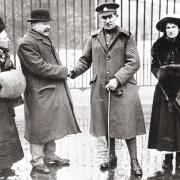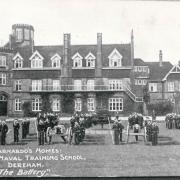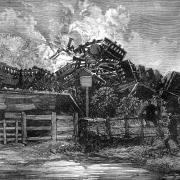Scarlet cloaks hang on hooks in the hallway. On a chest in the main room are the tall, black moleskin hats the sisters wear for formal occasions, and bonnets for less showy trips out. The very newest of the hats dates back to 1933, most are Victorian.
This is the Hospital of the Holy and Undivided Trinity in Castle Rising or, more simply, the beautiful village almshouses, just across the lane from the Norman church, and tucked around a corner from the impressive castle which gives the village its name.
It is home to six women who each live in a stone cottage, reached through a gatehouse and set around a garden quadrangle. The almshouses were built for 12 ‘sober spinsters and widows’ more than 400 years ago. The rules barred ‘beggars, harlots, scolds, drunkards and haunters of taverns and inns’ and stipulated prayers thrice daily and women ‘of honest life and conversation, religious, grave and discreet.’

A huge wooden table is flanked by benches, with grand carved chairs at the head and food. There are portraits of venerable historical figures on the walls and, on a cupboard at the far end, the tall black Tudor-style hats which have been part of the ceremonial costume of the Trinity Almshouse since it was founded in 1614 in memory of Henry Howard, Earl of Northampton.
‘He would probably have been the richest man in the country,’ said Richard Waite, the current clerk of the Hospital of the Holy and Undivided Trinity.

‘I love the atmosphere of peace and quiet and tradition,’ he said. ‘It is a community.’
There are pictures of lots of royal visitors too. With the Sandringham estate bordering the village, generations of kings, queens, princes and princesses have paid a visit to this peaceful, picturesque community.
The residents, who are known as ‘sisters’ each have their own patch of beautifully tended garden and the communal land, once a kitchen garden producing food for shared meals in the dining hall, is now looked after by the gardener for Lord Greville Howard, a descendant of the founder.

Nick Phillips, chief executive officer of the national Almshouses Association, said: 'The architecture of almshouses hasn’t changed much since the 10th or 11th century.'
Built as quadrangles, or three sides of a square, Nick said: 'They encourage companionship and interaction while giving private space inside. To walk to your front door you have to walk past each other and that’s not by accident, it’s about forming a strong community. You don’t feel lonely but you’re all completely independent.

'There’s an increasing recognition that there is something about the scale of almshouses that enables these communities to thrive. They offer warm, safe, secure homes to those in need. Strong companionship, good neighbours, independent living.’
Each woman lives independently, with as much outside care as she needs, although one of the residents at Castle Rising has the title of matron. She has extra frills on her beautiful scarlet special-occasion cloak and regularly checks in on her fellow residents.
The women include a former teacher, secretary and housekeeper. Each pays a weekly maintenance contribution from her pension or housing benefits, to help towards the running of the almshouses.
Richard said: 'They live a quiet life. They might visit the church or pub or tearoom in the village.’ But on special occasions they lift those glorious scarlet cloaks from the hooks in the hall, put on the fancy hats, and ensure a 410-year-old tradition continues through the 21st century.

The Earl of Northampton’s bequeathed money for another two sets of almshouses – one in Clun in Shropshire and one in Shotesham, south of Norwich.
Across the country around 36,000 people live in almshouses, including 84-year-old Josephine Mulligan of Stuart Court Almshouses, Norwich.
She has views, front and back, to the gardens which surround the pretty gabled architecture of the Dutch-style almshouses.

Josephine moved to Stuart Court with her husband 24 years ago and still enjoys helping out in the gardens. Alongside the beautifully cared-for beds and borders, she has added rhubarb, raspberries and blackcurrants. ‘I make blackcurrant jam every year’ said Josephine, ‘It’s absolutely gorgeous here. I love the community, being close to the railway station, close to everything really. You are right in the centre of everything but can hear the birds singing and see the wildlife’
Born in the Netherlands, the eldest of 10 children, she came to Britain as an au pair. She met her husband here and the couple moved to Norwich where Josephine worked as a teacher at Town Close House School. She was particularly delighted to discover the Dutch-influenced architecture of Stuart Court – although she has Norwich roots too. Her stonemason maternal grandfather helped build the Roman Catholic Cathedral.

Tucked between the Cathedral and Prince of Wales Road in Norwich city centre, the Stuart Court Almshouses were built in 1915 in memory of James Stuart, who married into the Colman family. They are looked after by the Norwich Housing Society. Its chief executive officer John Newstead said: ‘He was concerned with welfare and education and was very socially minded. He was a champion for poor people.’
When he died his sisters-in-law, Ethel and Helen Colman, wanted to recognise the work he had done. ‘After the 1912 floods the poor condition of Norwich housing became apparent so Ethel and Helen decided to build some new housing,’ said John.
Nick Phillips of the Almshouses Association said: ‘The philanthropists and activists of the time saw see people living in reduced circumstances and want to do something about it.’
Today eight men and 14 women live in 22 light and airy apartments which range from bedsits to two-bedroom flats. Applicants to join the waiting list must be over 60 with a connection to the city, in housing need and without the means to purchase their own property.

In tiny Freethorpe, near Acle, the prettily gabled Walpole’s Almshouses were built in 1871 by the Lord of the Manor of Freethorpe and his wife, Richard and Harriet Vade-Walpole. Originally created for six poor widows they are now three separate homes, for men and women.
The Grade II listed almshouses are still a haven for those in housing need and one resident called the little community a place of comfort, security, and attentive care.

The almshouse model dates back more than 1,000 years, with the Hospital of St Oswald in Worcester the very oldest almshouse charity still in existence. Early almshouses were often called hospitals because they offered hospitality to the oldest, poorest and most vulnerable in society.
Today almshouses still offer hospitality, with some extending that to provide homes for families and young people leaving care.
The Almshouse Association aims to help trustees promote provide good-quality housing for people in need, look after their historic buildings, promote the welfare and independence of residents and continue the tradition of almshouses for future generations.
almshouses.org




























